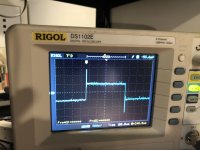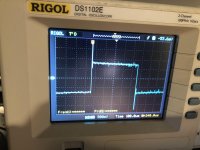This is very typical for these kinds of preamp circuit with tone control; they need to provide 16.5 dB of gain or thereabouts along the way.If you simulate that mess, subbing an op amp for the two transistors,
you'll see that there's still a HF peak, due to the chosen component values.
If the tone circuit had all symmetric component values for boost and cut,
there'd be no peak, since the two composite tone circuit impedances
(output to wiper, wiper to ground) would be equal, giving a gain of x2,
independent of frequency when both of the controls are centered.
But they aren't symmetric, hence the glitch.
These usually are a compromise in multiple respects; they generally aren't the last word in noise either. Then again, with a 250k volume pot, where do you even begin?
See if anything changes if you turn the oscilloscope's probes over the load.
Wouldn't that apply a short to the amplifier output depending on grounding arrangements of the amp, scope and sig gen?
It's not just an effect of the tone control circuitry. Have a look at the volume control: Even if loudness is off, there's still this 220 pF capacitor from it's hot end to the tap which emphasizes higher frequencies depending on the volume setting.
Best regards!
Best regards!
@rayma- thanks for the explanation-I think I understand the "why"- which for me is helpful as I learn more about circuits and their operations.- So it would seem the designer wanted a "treble lift" to give the amp a "clear and bright" sound- perhaps to differentiate it against the competition in the day?
@sgrossklass- why is the 250k value a problem?
@kay- the 220pf would seem only to be switched in when the loudness was activated?
and no I am not going to reverse the connections...🙂
@sgrossklass- why is the 250k value a problem?
@kay- the 220pf would seem only to be switched in when the loudness was activated?
and no I am not going to reverse the connections...🙂
As requested please take a screen shot again of one full 1kHz cycle, this time at various
volume levels (see post 24) . This way we can see a lift is inside the audible band or not.
volume levels (see post 24) . This way we can see a lift is inside the audible band or not.
thanks-how did you tell that? (excuse the dumb question)
and the spike only occurs after the tone section, there is not spike at the vase of X201
and the spike only occurs after the tone section, there is not spike at the vase of X201
Then again, with a 250k volume pot, where do you even begin?
I'd remove that whole tone circuit mess, even if there's a gain loss of 6dB.
x201 is the PNP transistor that takes the input from the volume pot via 470k and c201 (10uf)- the signal is clean there, bu has the spike on the output of x203.
also c131 and c132 are only switched in when the loudness is engaged (I think)
also c131 and c132 are only switched in when the loudness is engaged (I think)
Even if loudness is off, there's still this 220 pF capacitor from it's hot end to the tap which
emphasizes higher frequencies depending on the volume setting.
That's an old trick, even used by Theta in their preamp of the 70s.
So it would seem the designer wanted a "treble lift" to give the amp a "clear and bright" sound-
perhaps to differentiate it against the competition in the day?
It's likely around 20-30kHz, and so would only cause problems. Imagine having a tweeter
with a sharp resonance in the same frequency range.
Last edited:
It's likely around 20-30kHz, and so would only cause problems. Imagine having a tweeter
with a sharp resonance in the same frequency range.
ah well that would be awful
@kay- the 220pf would seem only to be switched in when the loudness was activated?
Yes, you're right! My look obviously wasn't close enough.
Best regards!
It's likely around 20-30kHz, and so would only cause problems. Imagine having a tweeter
with a sharp resonance in the same frequency range.
You probably forgot that there is zero programme energy at frequencies like this.
Yes, you're right! My look obviously wasn't close enough.
Best regards!
Well, in position 2, Loudness off, C131, 132 are switched in.
- Home
- Amplifiers
- Solid State
- JVC JA S22 squarewave overshoot


